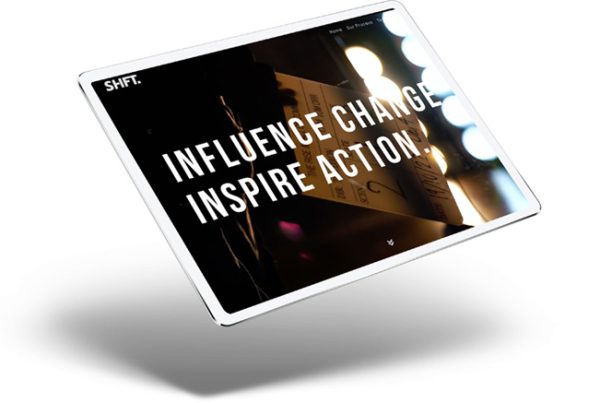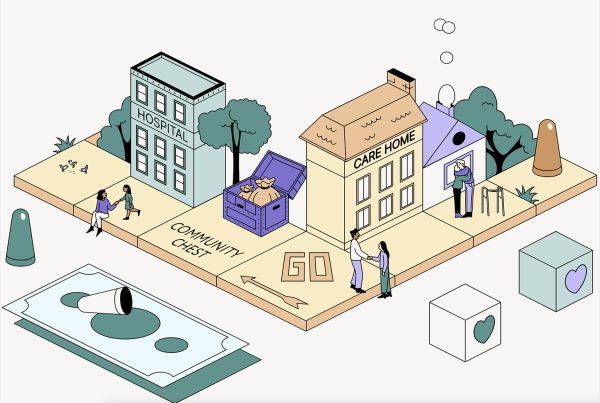What is digital?
According to Oxford English Dictionaries, the definition of digital (in reference to signals or data) can be expressed as series of the digits 0 and 1, typically represented by values of a physical quantity such as voltage or magnetic polarisation.
This rather complex sounding definition is almost always delivered alongside the definition of Analogue, which is essentially the opposite of digital and represents changing values as continuously changing physical quantities. These qualities could for example be spatial position, perspective or wattage.

As humans we view the world in analogue – i.e we see all of the information in front of us rather than a freeze-frame or snap shot. To explain, think of photographs in newspapers. The printed matter usually consists of a series of dots that are either black or white. The reader does not however see the printed matter as dots (the digital format of the image) but they can see light, dark and contrasted shading as a continuous image.

The laptops, tablets and smart phones that we use in our daily lives are all digital machines, meaning that in the most basic form they can be defined by discrete units called ‘bits’ that are either on or off, or as mentioned previously, can transmit signals of values between 0 and 1. When you access a search engine and for example type in ‘Web Design London‘ as soon as you click ‘search’ digital signals are transmitting data across the world wide web trying to find your search results! It is difficult to be seen as a business if you are not ‘digital’ and do not have a online presence. This is where the importance of digital publishing comes in.
What is digital publishing?
Digital publishing is the digitisation, production and sales of material which might usually or traditionally be printed on paper.
Digital publishing, also known as electronic publishing or e-publishing, is any type of publishing that involves disseminating information like texts, video and audio, digitally. Digital doesn’t necessarily mean that is it limited to the web, digital publishing can also occur in DVD, CD and Blue Ray production.

The role of web design and development in Digital Publishing
Digital publishing is essential to broadening your audience scope and reach. We live in a world that is becoming increasingly more digital. We crave efficiency and want access to information at the click of a mouse. The role of web design and development in digital publishing is a big one. With the amount of self-published material increasing by 50% in the last 5 years, it is important that digitally published documents are well designed and intuitive to the way the user might navigate the material. Digital publishing and web design and development experts should really be in deep conversation about making information accessible on the web and allowing users to have the best possibility of discovering information and content through the clever use of aesthetics and intuitive ‘humanised’ design.
Here’s a few thing that need to be considered when publishing digital projects:
- creative design presentation
- logical navigation and content organization
- responsive design structure
- knowledge and ability to conceptualise visual storytelling
- optimize images for web
- make digital content usable!
A brief history of digital publishing
To pay homage to the inventor of the printing press Johannes Gutenberg, Project Gutenberg (1971) founded by Michael S. Hart oversaw the project to firstly digitising the American declaration of independence and then encourage the creation and distribution of eBooks. The project went on to be the creation of the largest digital library ever.
The early 90s saw the explosion of the world wide web. People were very excited to be so connected with the rest of the world and the Web was a perfect platform to transfer documents. Then early 90s also the CD rom drive was very common on computers. They were used to cut production costs and publishers starting producing their titles on dvd as a way to make the content of the books, more readily available and ‘searchable.’ Textbooks and Encyclopedias started to be produced with live action presentation supplement content on dvd. The Adobe PDF(Portable Document Format) was also launched in the early 90s, this was a pioneering time for digital publishing. It was also around this time that Amazon also started to sell printed books online.

Skip forward 10 years and the popularity of books paired with the desire for the digital, Sony introduced the first e-reader the Sony Libre. The Libre was a device for reading which used e-ink technology which meant visibility of the text required zero back lighting but just reflected light much like paper.
In 2004 Google announced their plans to digitise and produce all of their books digitally for sale online. This was a big step for Google as they have always been considered to be great leaders in the tech industry – this was one big nod to digital publishing.
Then hop forward a few years again to 2007 when Amazon produced the Kindle. The model has been updated yearly and has sold out at record breaking speed. It only took Amazon a only takes a few years to realise that their eBooks were far outselling regular books!

Also in 2007 Apple announced the iPhone and although people though this may challenge the Kindle e-reader, the screen size meant that the iPhone was not a major player at all in the digital publishing world, the device was just too small for any extended reading, but had the great benefits of carrying a computer in your back-pocket essentially.
Enter 2010 and the birth of the iPad. Now ‘this’ was a real game changer in the digital publishing world as it combined great internet capabilities, multi-functionality and all the required aspects of an e-reader. The iPad combined the ability, to pinch the screen, swipe content and scroll, zooming in and highlighting the necessary content. Although one negative of using the iPad as your e-reader device is the constant distraction. On a tablet you are not able to fully immerse yourself in the same way as reading a book as you are likely to be distracted by notifications of incoming email, status updates, and messages.
Digital publishing and the devices we access the information on are continually being developed but mostly we access the information from our desktops and smart phones. It seems the majority of us, are part of this multi-tasking generation, who like to read, listen and watch all within the same platform so that we can access cross-media information seamlessly.

Modes of digital publishing:
Digitally published media might include:
- E-books
Digital books/texts readable on computers or e-reader devices. Jennifer Schiessler, reported in the New York Times back in 2010 on 20th Century Writer Bob Browns earliest prediction of the e-reader in which he described it as ‘The machine that allow readers to adjust the type size, avoid paper cuts and save trees…’ Which has partly been the secret to the e-books success. - CD – Rom
CD Rom (or compact disc read only memory) specifically designed to store computer data in the form of text and graphics, as well as hi-fi stereo sound. This form of digital publishing was popular in the late 90s and early 2000s as a way to provide files that accompany printed materials – prior to the wide use of web publishing. - E-newsletters and emails As it says on the tin, e-newsletters and emails are electronic versions of paper newsletters or mail. It has become the norm that checking your emails is the very first thing you do in the morning. E- newsletters also referred to as e-shots are important components in business marketing campaigns and a great way to contact various people of your mailing lists and can be designed with the company branding in mind.
- Online newspapers/magazinesMany newspapers and magazines were forced to digitise their content, as drops in sales meant they their content was just no longer reaching the readership desired. Digital means a global reach, and the UK Magazine The Economist said at the end of last year their digital sales had increased 300% in 1 year! This magazine and many other international newspapers are deciding to go digital for many reasons surpassing global reach – paper saving and energy saving is also a massive bonus of digital news.
- Blogs
A blog is exactly what you are looking at right now. Sometimes a text flow of consciousness and sometimes much more considered, a blog is essentially a digital diary, that is shared across the web. - Podcasts
A podcast is a digital audio file made available on the Internet for downloading to a computer or portable media player, typically available as a series or instalments. Podcasts are quite ‘trendy’ at the moment, with many people preferring audio books to written documents, as it gives them more flexibility and tasking capabilities. - Mobile apps
A mobile app is a software application developed specifically for on devices such as smartphones and laptops. Mobile apps, are developed within the abilities and constraints of the device they work on and are different to a responsive website design for example as they are especially created for a particular platform. - Online Video
According to Forbes, business and financial magazine the average Internet user spends 88% more time on a website that has video content that a website that doesn’t. That’s a pretty huge statistic. Video is important in marketing campaigns, and forms a lot of the foundations of companies online presents and interactivity with their client base.
The future of digital publishing
Future challenges:
One problem of digital publishing, is the design process. Magazine publishers and eBook designers have often used Adobe InDesign to create their layouts. What publishers need is multiple device enabled design layouts to be covered by a one off ‘design’ workflow. InDesign unfortunately does not create ‘responsive’ layouts, and also creates an ‘image’ of the page, as opposed to HTML layouts, which use rich text, meaning searchable functionality, shareable content, and flexible in publishing terms, i.e.: make your content once, send it wherever it needs to go. InDesign cannot do that right now unless you publish to PDF. Which is not always ideal.

Moving to the future:
Urban lifestyle lads mag Penthouse announced last week that it will be going digital after 50 years in print. Jonathan Buckheit, FriendFinder Network CEO who bought Penthouse in 2004 says that the magazine has been ‘Reimagined for the preferred consumption of content today by consumers, the digital version of Penthouse Magazine will combine and convert everything readers know and love about the print magazine experience to the power of a digital experience….we will seamlessly combine our unmatched pictorial features and editorial content with our video and broadcast offerings.’
The future and beyond:
Digital publishing in my opinion is going to get bigger and bolder in the coming years. Much like designers with a knowledge of traditional print techniques and also have knowledge of advanced web design techniques, it is probably that the most successful writers in the future will be those who have one foot in traditional publishing and one foot in digital publishing. There are hundreds of new formats of digital publishing, this is working in the favour of advances in web design and development as it will continue to make the web an accessible source of knowledge and information for everyone.
If you would like us to design or develop your next e-newsletter, marketing campaign or website then please get in touch.


